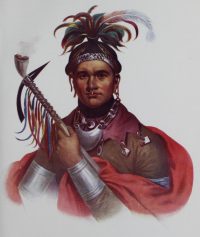A historic pipe tomahawk has returned to the New York State Museum 70 years after it was stolen by person or persons unknown. The tomahawk belonged to Allegheny Seneca war chief Cornplanter who received as a diplomatic gift from President George Washington in 1792. As war chief, Cornplanter had led the Seneca as allies of the French against the British in the French and Indian War. He took on the war chief mantle again during the Revolutionary War, this time on the British side. His involvement was against his better judgment as he thought the Iroquois nations should remain neutral. He was outvoted, however, and reluctantly did his duty.
 Cornplanter, fighting with Loyalist forces, was successful as a war leader. Pro-Independence settlers were killed and their properties were burned, and the Colonists did the same to Iroquois towns. George Washington dispatched Major General John Sullivan to eliminate the Iroquois in New York state and he did just that, first defeating them in pitched battle and then systematically burning every village, farmed field, food store and animal from May to September of 1779. When winter came, the surviving Iroquois had nothing to live on. The refugees headed up to Canada, Cornplanter trying his best to get them to safety, but many of them died from starvation and cold.
Cornplanter, fighting with Loyalist forces, was successful as a war leader. Pro-Independence settlers were killed and their properties were burned, and the Colonists did the same to Iroquois towns. George Washington dispatched Major General John Sullivan to eliminate the Iroquois in New York state and he did just that, first defeating them in pitched battle and then systematically burning every village, farmed field, food store and animal from May to September of 1779. When winter came, the surviving Iroquois had nothing to live on. The refugees headed up to Canada, Cornplanter trying his best to get them to safety, but many of them died from starvation and cold.
With the war lost and the Colonists colonists no more, Cornplanter turned to his diplomatic skills. He helped negotiate and was a signatory of the Treaty of Fort Stanwix in 1784 and met personally with President George Washington in 1790 to protest how the Seneca and other Iroquois nations were being treated, treaties notwithstanding.
Pipe tomahawks were significant objects of intercultural exchange in the 18th century and could be used as smoking pipes; smoking was a common ceremonial practice between parties after reaching an agreement. The meetings between Washington and Cornplanter, also known as Gy-ant-waka, in the 1790s eventually led to the Treaty of Canandaigua (1794), which established peace between the sovereign nations of the U.S. and the Haudenosaunee (Iroquois) Confederacy.
Cornplanter died in 1836. There is no record of the movements of the ceremonial pipe tomahawk until 1850 when it was donated to the New York State Museum by Seneca statesman, civil engineer, attorney and Union lieutenant colonel Ely Samuel Parker. He acquired it from the widow of a Seneca man named Small Berry. The haft was not original when Parker got the tomahawk, but Cornplanter’s name in the Seneca language, Gy-ant-waka, was engraved on one side of the blade identifying it as the historic piece. The name John Andrus engraved on the other side is unknown but is thought to have been the manufacturer.
Small Berry’s widow described the original haft to Parker, so he replaced the replacement with a replica that came as close as possible to her description: curly maple decorated with bands and geometric spade/arrowhead-like shapes of silver inlay. While he was at it, Parker added a brass plate engraved with his own name to the bore end.
The pipe was an important piece in the museum’s ethnographic collection for decades. It disappeared between 1947 and 1950, it’s not clear exactly when or how. Whoever snatched it, it wound up in the murky penumbra of private collections until June of this year when one last anonymous collector finally had the decency to return it to the State Museum. It is now on display in the museum’s main lobby through December 30th.


That ‘John Andrus’ metalworks, casting away ‘francisca’/ tomahawk style smoking pipes, i.e. primarily as trade goods (maybe in exchange for furs and leather, maybe even farmland) should be rather easy to identify.
If I may ask: What exactly did Leonard’s Grampa do? Where did the steel come from, and what should be the exact ‘word’ for describing all this?
———-
1819 – Jethro Wood’s iron plow with interchangeable parts
1837 – John Deere and Leonard Andrus(!) begin manufacturing steel plows
So we can assume that the portrait was just so much fabrication… :yes:
The Iroquois Confederacy’s greatest legacy is their democratic government, the basis of our democratic government, but they have not received recognition for this contribution.
Ely Parker is a particularly interesting character. He was a brevet Brigadier General, not a Lt. Col.. He was U.S. Grant’s military secretary who drafted Lee’s surrender at Appomattox. He also served in the Grant presidential administration as the first Native American to head the Bureau of Indian Affairs.